Here is a review of the many things we did Term Two 2023-2024!
To tie the big ideas from our curriculum together into a larger, enduring understanding,
we studied all subjects through the lens of universal, conceptual themes.
First, we focused on the concepts of
CREATIVITY and CHANGE
in our unit
“Human Creations”
Unit Focus Statement:
We use creativity and knowledge together to make innovations that change our world.
Core Competency Focus:
Creative Thinking
What is creativity?
(Core Competencies, Science, Career Education, ADST, Socials, Language Arts)
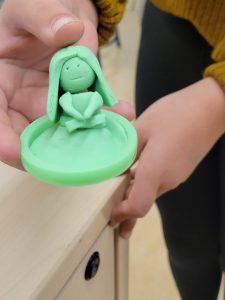 We used this unit to better understand the nature of creativity. What is it? Who has it and why? Can we cultivate it? Can it be taught? We did a variety of activities to explore creativity, such as reading a collection of picture books about imagination and ideas; doing theatre improvisation; creating Scratch programming and games as part of the Hour of Code week in December; and constructing maker art for the holidays out of mixed media such as wool and found objects.
We used this unit to better understand the nature of creativity. What is it? Who has it and why? Can we cultivate it? Can it be taught? We did a variety of activities to explore creativity, such as reading a collection of picture books about imagination and ideas; doing theatre improvisation; creating Scratch programming and games as part of the Hour of Code week in December; and constructing maker art for the holidays out of mixed media such as wool and found objects.
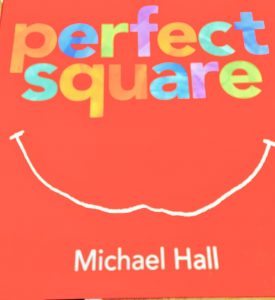 Some activities were designed as “alternative uses” tests, which are often employed by researchers to test creativity. How many things can you make out of a small can of playdoh in a short time period?
Some activities were designed as “alternative uses” tests, which are often employed by researchers to test creativity. How many things can you make out of a small can of playdoh in a short time period?
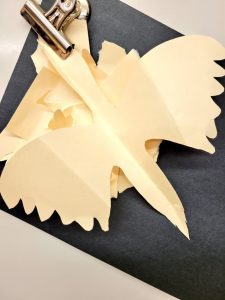 We read the book The Perfect Square, then everyone took a plain, boring piece of paper, and with only five cuts and folding, constructed new 3D creations from our imaginations.
We read the book The Perfect Square, then everyone took a plain, boring piece of paper, and with only five cuts and folding, constructed new 3D creations from our imaginations.
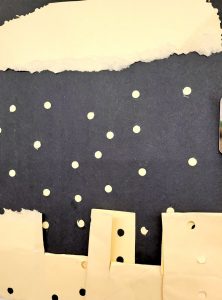 We watched several TED talks about creativity, and we did shared, non-fiction readings from the Time Magazine: Creativity Issue to better understand the brain science behind creativity, and how people think creativity can be cultivated in our learning and daily lives. We also talked about how GROUP THINK can be better than SOLO THINK for any project. Building upon someone else’s ideas is okay, and it is the way innovation happens!
We watched several TED talks about creativity, and we did shared, non-fiction readings from the Time Magazine: Creativity Issue to better understand the brain science behind creativity, and how people think creativity can be cultivated in our learning and daily lives. We also talked about how GROUP THINK can be better than SOLO THINK for any project. Building upon someone else’s ideas is okay, and it is the way innovation happens!
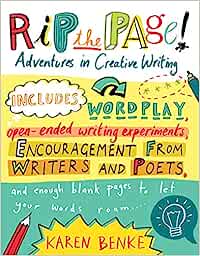 As part of language arts, and in connection with our school goals around writing, we also took time to do daily, creative quick-writes during our recalibrate time to focus our energy for the day. The emphasis was on increasing written output, idea generation strategies, and using more complex vocabulary. We discussed the difference between 5 cent, 10 cent, and 25 cent words. More interesting vocabulary means our writing is worth more! We also discussed not self-censoring — meaning, just get the thoughts to paper in a first draft and don’t worry so much about perfection! All ideas are good!
As part of language arts, and in connection with our school goals around writing, we also took time to do daily, creative quick-writes during our recalibrate time to focus our energy for the day. The emphasis was on increasing written output, idea generation strategies, and using more complex vocabulary. We discussed the difference between 5 cent, 10 cent, and 25 cent words. More interesting vocabulary means our writing is worth more! We also discussed not self-censoring — meaning, just get the thoughts to paper in a first draft and don’t worry so much about perfection! All ideas are good!
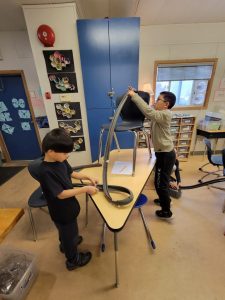 We discussed the nature of PLAY and developing creative thinking skills. How do younger children feel and touch materials as they explore their potential uses? Why do younger children have a different attention span? Why does the way we play change as we get older? We did some primary research about this by teaching our younger buddies how to do marble roller coasters like we did earlier this year, then observing them to see how their play and experimentation differed from our own.
We discussed the nature of PLAY and developing creative thinking skills. How do younger children feel and touch materials as they explore their potential uses? Why do younger children have a different attention span? Why does the way we play change as we get older? We did some primary research about this by teaching our younger buddies how to do marble roller coasters like we did earlier this year, then observing them to see how their play and experimentation differed from our own.
How do we make work easier? With simple machines!
(Science, Math, and ADST)
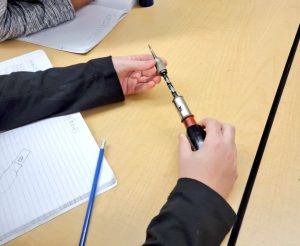 Creativity is important to solve problems! We explored how humans have used experimentation and scientific knowledge to create simple machines that make work easier. To begin our discussion, a pile of weird tools from Ms. D’s and Mr. L’s eclectic collection, including some antiques, were put out on tables for students to explore and draw. Everyone had to guess what the tools are used for and how they work!
Creativity is important to solve problems! We explored how humans have used experimentation and scientific knowledge to create simple machines that make work easier. To begin our discussion, a pile of weird tools from Ms. D’s and Mr. L’s eclectic collection, including some antiques, were put out on tables for students to explore and draw. Everyone had to guess what the tools are used for and how they work!
Then, we identified the main simple machines and did hands-on activities to experiment with them. Let’s lift Ms. D up with one student using a giant wood lever and fulcrum!
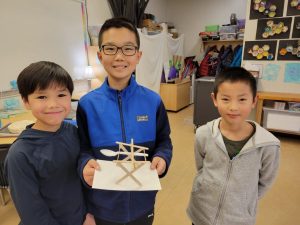 We identified the steps of the design process, then created several devices using creative thinking and simple machines. First, we made marshmallow catapults, seeing who, with limited time and materials, could build a device that would successfully launch marshmallows the furthest across the classroom.
We identified the steps of the design process, then created several devices using creative thinking and simple machines. First, we made marshmallow catapults, seeing who, with limited time and materials, could build a device that would successfully launch marshmallows the furthest across the classroom.
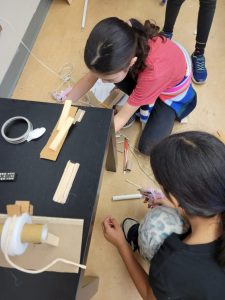 Then, we researched Rube Goldberg, who designed machines that were very complicated, but completed very easy tasks! We created Rube Goldberg devices all over the classroom, using a variety of found materials and the design process.
Then, we researched Rube Goldberg, who designed machines that were very complicated, but completed very easy tasks! We created Rube Goldberg devices all over the classroom, using a variety of found materials and the design process.
Finally, we also learned about hydraulics, discovering how liquids, unlike other states of matter, can’t be compressed! Working collaboratively, we made cranes and other unique devices.
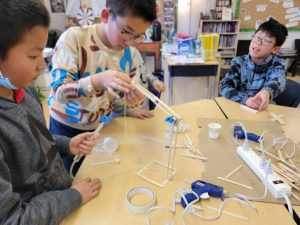
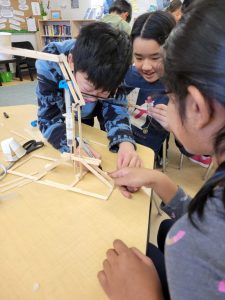
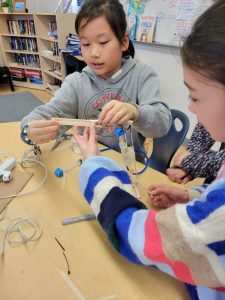
Human Innovations over Time — The concept of CHANGE
(Socials, Language Arts, Core Competencies)
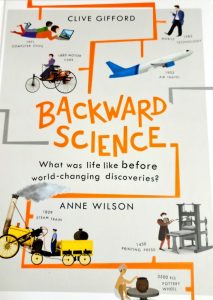 Our creativity has led to many innovations that have changed our lives over time. What are those innovations? When did we start using simple machines? Has our use of technology been positive or negative? We had many discussions about the impact of technology, as well as the history of human creations. The book Backward Science gave us a better idea of what life was like before we had inventions like the toilet or the car! We looked at early Indigenous innovations, as well, such as snow goggles, inukshuks, umiaks, burins, spindle whorls, and ulus.
Our creativity has led to many innovations that have changed our lives over time. What are those innovations? When did we start using simple machines? Has our use of technology been positive or negative? We had many discussions about the impact of technology, as well as the history of human creations. The book Backward Science gave us a better idea of what life was like before we had inventions like the toilet or the car! We looked at early Indigenous innovations, as well, such as snow goggles, inukshuks, umiaks, burins, spindle whorls, and ulus.
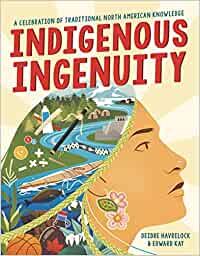 We read the book Ingenious and were surprised how many important innovations originated in Canada! We learned how many other inventions have been inspired by creations from First Peoples of Canada by looking at the book Indigenous Ingenuity.
We read the book Ingenious and were surprised how many important innovations originated in Canada! We learned how many other inventions have been inspired by creations from First Peoples of Canada by looking at the book Indigenous Ingenuity.
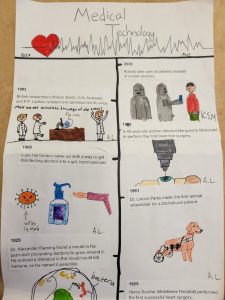
Then, we identified technologies used in different areas of our lives, such as communication, medical technology, electronics, and entertainment; then we evaluated each one for its positive and negative impacts on humans. Each student chose to research one area further, creating a timeline to illustrate how technologies have changed over time.
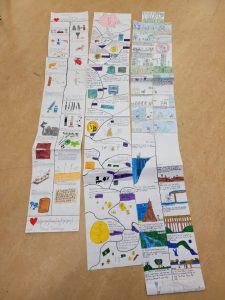 As we did research, we focused on how to evaluate online sites to ensure they are legitmate sources, how to ask questions about your topic first before starting the research process, and how to document notes in a two-column format in your own words, citing where you found the information.
As we did research, we focused on how to evaluate online sites to ensure they are legitmate sources, how to ask questions about your topic first before starting the research process, and how to document notes in a two-column format in your own words, citing where you found the information.
We read the books Goodnight iPad and Nerdy Birdy Tweets to discuss how technology such as smartphones and social media can distract from other activities or relationships. We watched The Story of Plastics to learn about the impact of the invention of plastic on both us and the environment. As we read about the invention of the printing press, we reflected on how much technology has changed us and the way we do things.
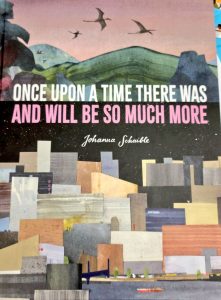
We also did some self-reflection about how we have CHANGED over time, too! We read the book Once Upon A time There Was and Will Be So Much More, then brainstormed how we have changed since being a baby. After, we imagined what we would be doing next year, in ten years, and in fifty years!
Finally, each student did a PowerPoint presentation on the innovation or invention they believed was the most impactful on human lives. This allowed everyone to practice creating aesthetic presentations, giving and receiving constructive feedback, and researching while using reliable resources.
Math is a Creative Tool for Innovation! (Math and Critical-Thinking Strategies)
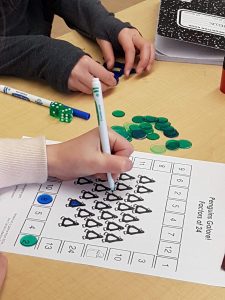
How can we approach multi-digit multiplication with creative thinking? Why do we use multiplication, and what is it? Using Carole Fullerton’s Multiplicative Thinking, we played games to learn about multiples, factors, prime factor trees, squared numbers, exponents, and math properties (distributive, associative, and commutative.) We experimented with many different ways of solving 2 by 2 multiplication problems, such as the window, the FOIL method, mental math, and the traditional column approach.
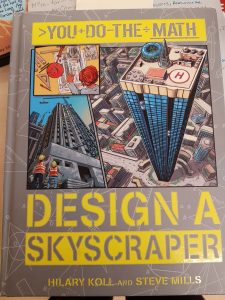 Using You Do the Math: Skyscrapers, we looked at the combination of math knowledge needed to build new things such as skyscrapers! This included understanding geometric solids, measurement, reading tables, plotting coordinates, area, and perimeter. We did problem solving involving basic fractions and decimals, and some students did surface area or algebraic challenges. This work continued into our next unit on migration. Stay tuned for pictures of our work making Tiny Houses for ADST and Math, applying what we learned in term two!
Using You Do the Math: Skyscrapers, we looked at the combination of math knowledge needed to build new things such as skyscrapers! This included understanding geometric solids, measurement, reading tables, plotting coordinates, area, and perimeter. We did problem solving involving basic fractions and decimals, and some students did surface area or algebraic challenges. This work continued into our next unit on migration. Stay tuned for pictures of our work making Tiny Houses for ADST and Math, applying what we learned in term two!
Creativity in the Arts and ADST!
(Fine Arts, ADST, Core Competencies)
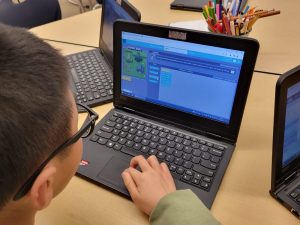 As we came closer to Winter Break, the class decided to have a Winter Theme for the classroom. So, we focused our creative thinking skills on making stuff to help decorate and to give as gifts during the holidays. We also participated in the HOUR OF CODE, a celebration of coding all over the world!
As we came closer to Winter Break, the class decided to have a Winter Theme for the classroom. So, we focused our creative thinking skills on making stuff to help decorate and to give as gifts during the holidays. We also participated in the HOUR OF CODE, a celebration of coding all over the world!
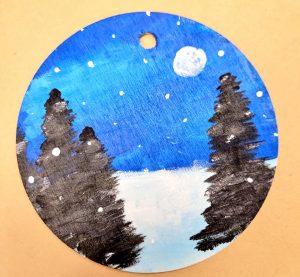 We worked with new materials and learned new methods of creation, such as wool felting, collage, and acrylic landscape painting on wood. Hopefully everyone enjoyed seeing the results at home!
We worked with new materials and learned new methods of creation, such as wool felting, collage, and acrylic landscape painting on wood. Hopefully everyone enjoyed seeing the results at home!
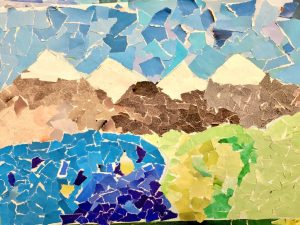
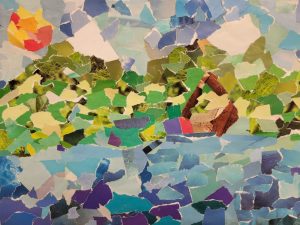
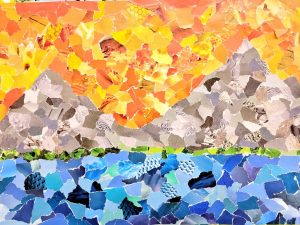
For our SECOND UNIT in TERM TWO,
we focused on the concepts of
EXPLORATION and IDENTITY
in our unit
“On the Move!”
Unit focus statement:
Migration is a response to challenges, risks, survival, and a natural need to explore.
Core Competency Focus:
Positive Personal and Cultural Identity
**Please note, we will be finishing this unit up until Spring Break,
and so we will be adding to this entry with photos as student work is completed,
and report cards will reflect only what we are able to finish before February 29th.
How am I an explorer?
(Career Education, Social Thinking, Core Competency of Positive Personal and Cultural Identity)
 What does it mean to be an explorer? What would you feel and do? We unpacked the meaning of exploration and realized it does not only apply to ancient explorers who crossed the seas. It can apply to us and involve risk-taking, or careful, methodical observation for art, science, and research. It can also mean making an effort to explore one’s identity and culture.
What does it mean to be an explorer? What would you feel and do? We unpacked the meaning of exploration and realized it does not only apply to ancient explorers who crossed the seas. It can apply to us and involve risk-taking, or careful, methodical observation for art, science, and research. It can also mean making an effort to explore one’s identity and culture.
Through exercises in the book How to be An Explorer of the World, we will continue to hone our observation and noticing skills, particularly through explorations outside as the weather improves. We are also reading many picture books to facilitate discussions about our own identity, culture, and acceptance of others’ identities.
Migration — Humans
(Socials, Science, Language Arts, Core Competency of Positive Personal & Cultural Identity, French)
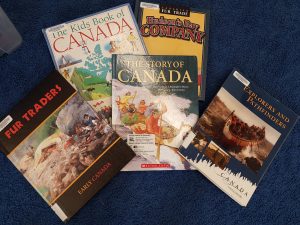
Why do people move from place to place? What is your own migration story? How did we all get here in Canada?
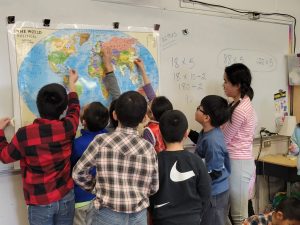 Students started by asking their parents for information about their family tree and the journey their family took to arrive here. We charted all of our migration paths on a large map for all to see. Through this, we had great discussions about the diverse backgrounds and cultural beliefs in the classroom. Even though we are all different, we found we had many things in common! For example, we all have traditions to mark important events, certain ways of doing things in the home, and objects and practices that are important to us. Thank you, Division 5, for our respectful and interesting discussions!
Students started by asking their parents for information about their family tree and the journey their family took to arrive here. We charted all of our migration paths on a large map for all to see. Through this, we had great discussions about the diverse backgrounds and cultural beliefs in the classroom. Even though we are all different, we found we had many things in common! For example, we all have traditions to mark important events, certain ways of doing things in the home, and objects and practices that are important to us. Thank you, Division 5, for our respectful and interesting discussions!
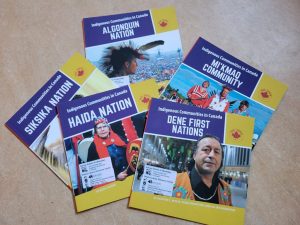 Our next step was to look closely at the Indigenous or First Peoples of Canada, whose history on these lands is much, much longer than ours. How did they come here? What are the main Indigenous groups of Canada? How many Indigenous groups existed here for such a long time before European explorers and other settlers arrived? Each student did research on groups they were less familiar with, like the Algonquin, Dene, Cree, and Iroquois First Nations communities. Then, we did more in-depth work to learn more about the Coast Salish groups, on whose unceded territories we live, work, learn, and play. Thank you, Division 5, for your respectful conversations about land acknowledgements and why we do them.
Our next step was to look closely at the Indigenous or First Peoples of Canada, whose history on these lands is much, much longer than ours. How did they come here? What are the main Indigenous groups of Canada? How many Indigenous groups existed here for such a long time before European explorers and other settlers arrived? Each student did research on groups they were less familiar with, like the Algonquin, Dene, Cree, and Iroquois First Nations communities. Then, we did more in-depth work to learn more about the Coast Salish groups, on whose unceded territories we live, work, learn, and play. Thank you, Division 5, for your respectful conversations about land acknowledgements and why we do them.
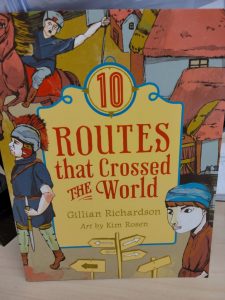 Using the book Human Migration on EPIC, Why We Live Where We Live, and many other resources, we discussed the many push and pull factors that cause humans to move from place to place. We talked about how some people move all the time because of a “restless gene” that just makes them seek novelty and something new!
Using the book Human Migration on EPIC, Why We Live Where We Live, and many other resources, we discussed the many push and pull factors that cause humans to move from place to place. We talked about how some people move all the time because of a “restless gene” that just makes them seek novelty and something new!
Each student is doing some GEOGRAPHY studies to learn about the different countries in each continent and expand their international mindedness about the world. It allowed is to also talk about where certain languages have come from in the world, which parts of the world were explored by who, and which countries are FRENCH speaking. Each student chose a French-speaking country to research further and produced a colourful poster to inform the class of their findings.
Ms. D has a large map in the classroom with quality of life data on each country, and this allowed us to have discussions about why people move from one place to another as an immigrant or refugee.
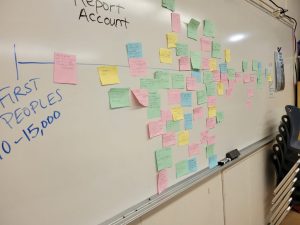 Using a TON of great books from the District Library, we did a group inquiry about “How did we get here?” How did we all come to be in Canada? What were the reasons people came here? We made a timeline on the board and listed the many reasons people came, such as trade, land, gold, and escaping war.
Using a TON of great books from the District Library, we did a group inquiry about “How did we get here?” How did we all come to be in Canada? What were the reasons people came here? We made a timeline on the board and listed the many reasons people came, such as trade, land, gold, and escaping war.
Each student chose a historical figure to represent from this timeline, and each student presented a monologue as part of our “Museum of History!”
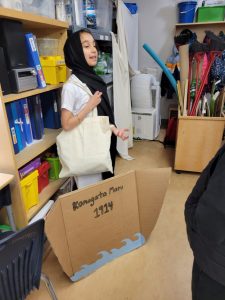
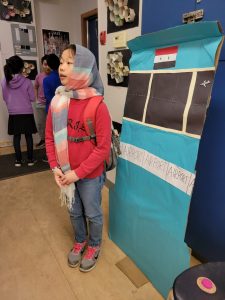
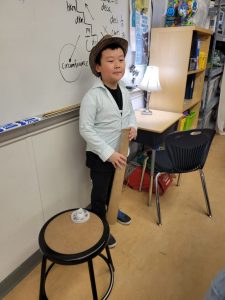
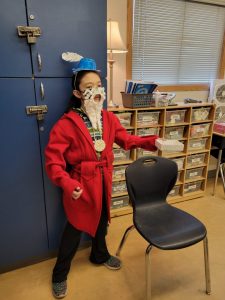
Students also looked at 10 different case studies of people trying to come into Canada and made decisions about which 5 would get to come in. This is part of an ongoing conversation about immigration policy in Canada and how the government makes decisions about who it lets in to the country. What is the difference between a permanent resident and a citizen? Is it required to speak English or French?
 To better understand what it is like to be a refugee or immigrant, we also read aloud the book We’re Not From Here by Geoff Rodkey. It is a science fiction story that imagines what might happen if the Earth were uninhabitable, and we all had to immigrate to another planet. Would we be accepted? What would it be like to live in such a different place? What would it be like to be called the “alien”? Students used elements of Reading Power by Adrienne Gear to visualize details, make personal connections, and think more deeply while reading.
To better understand what it is like to be a refugee or immigrant, we also read aloud the book We’re Not From Here by Geoff Rodkey. It is a science fiction story that imagines what might happen if the Earth were uninhabitable, and we all had to immigrate to another planet. Would we be accepted? What would it be like to live in such a different place? What would it be like to be called the “alien”? Students used elements of Reading Power by Adrienne Gear to visualize details, make personal connections, and think more deeply while reading.
Migration – Animals and Getting Outside
(Science, Socials, Language Arts, ADST, PHE)
Humans aren’t the only ones moving around! Using National Geographic resources, we looked at the migration routes of the red crab, the wildebeest, whales, and monarch butterflies. We discussed the different reasons animals migrate, as well as the many internal or external cues animals use to know when it is time to move.
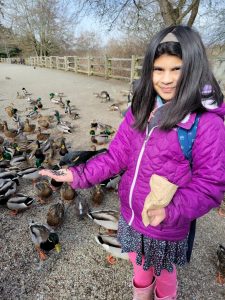 We also visited the beautiful Reifel Bird Sanctuary! This is one of the local, protected estuaries where you can find migratory animals this time of year. We learned about local bird species, the essential things animals need to survive, and why the estuary is a popular stop on migration routes. Many of us fed birds for the first time, and we saw pintail ducks, chickadees, saw-whet owls, and red-winged blackbirds, among other species.
We also visited the beautiful Reifel Bird Sanctuary! This is one of the local, protected estuaries where you can find migratory animals this time of year. We learned about local bird species, the essential things animals need to survive, and why the estuary is a popular stop on migration routes. Many of us fed birds for the first time, and we saw pintail ducks, chickadees, saw-whet owls, and red-winged blackbirds, among other species.
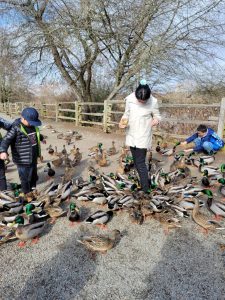
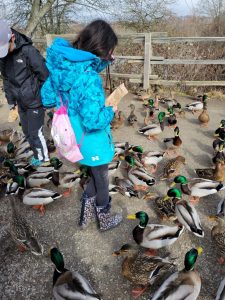
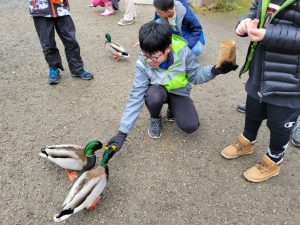
Each student then chose a migratory animal to research further and created a Book Creator presentation about their findings using the iPad. We will be presenting these to one another after spring break.
Our walk at Reifel Bird Sanctuary and around the school, listening for birds outside, were a part of our physical and health education, as we focused on getting outside, breathing fresh air, and learning to make mindful observations for both science and our own mental health. This was in combination with other outdoor team-oriented games, such as kickball and ultimate frisbee, which required us to use our social-thinking skills!
Independent Project Beginnings – Asking Deeper Questions
(Socials, Science, Language Arts)
 Each year, Division 5 students take on a passion topic of their choice to research, which leads to presentations to the community in mid-June. In January, everyone chose a topic and brainstormed questions to begin their research. Ms. D taught everyone about how to ask deeper questions using the Jar of Inquiry Model. After a beginning list of questions was created, students began their initial research.
Each year, Division 5 students take on a passion topic of their choice to research, which leads to presentations to the community in mid-June. In January, everyone chose a topic and brainstormed questions to begin their research. Ms. D taught everyone about how to ask deeper questions using the Jar of Inquiry Model. After a beginning list of questions was created, students began their initial research.
Ms. Ho, our librarian, will be working with Ms. D to provide as many books as we can to support the chosen topics. It is also important students visit their local, public library and begin to look for resources.
Art, Identity, and Quilt of Belonging
(Socials, Fine Arts, Core Competencies)
First, we brainstormed what makes up an IDENTITY? How do we know what our identity is? What represents our identity? This meant thinking more deeply about cultural, gender, and individual versus family identity, and we had a great discussion about how it is a journey discovering everything about yourself!
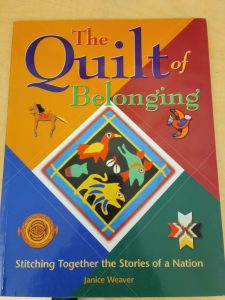 We read the book Quilt of Belonging and learned about the quilt that was made to represent the multicultural nature of Canada, with a square for each nation or ethnic identity that has come to Canada and contributed to the fabric of who we are as a whole group. Each student then created their own identity square to make a class quilt, which will be displayed after break.
We read the book Quilt of Belonging and learned about the quilt that was made to represent the multicultural nature of Canada, with a square for each nation or ethnic identity that has come to Canada and contributed to the fabric of who we are as a whole group. Each student then created their own identity square to make a class quilt, which will be displayed after break.
Tiny House Revolution!
(Identity, Math, Applied Design, Career Education)
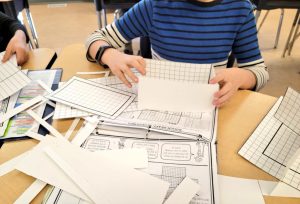 People are choosing to live in less space, so their impact is less on the world. How does a living space represent you and your beliefs about what is essential? What choices would you make? Using our ongoing work with multiplication, measurement, geometry, and proportionate reasoning that we began during unit two, as well as the design process, students created tiny house models, then discussed the area and perimeter, as well as the personal choices they made for their final creations. Pictures to come as we keep working on these projects before break!
People are choosing to live in less space, so their impact is less on the world. How does a living space represent you and your beliefs about what is essential? What choices would you make? Using our ongoing work with multiplication, measurement, geometry, and proportionate reasoning that we began during unit two, as well as the design process, students created tiny house models, then discussed the area and perimeter, as well as the personal choices they made for their final creations. Pictures to come as we keep working on these projects before break!
Overall, term two has been rich with learning experiences, and this overview is only a snapshot! We look forward to term three, with new units and our independent project presentations in June!



































 To better understand what it is like to be a refugee or immigrant, we also read aloud the book We’re Not From Here by Geoff Rodkey. It is a science fiction story that imagines what might happen if the Earth were uninhabitable, and we all had to immigrate to another planet. Would we be accepted? What would it be like to live in such a different place? What would it be like to be called the “alien”? Students used elements of Reading Power by Adrienne Gear to visualize details, make personal connections, and think more deeply while reading.
To better understand what it is like to be a refugee or immigrant, we also read aloud the book We’re Not From Here by Geoff Rodkey. It is a science fiction story that imagines what might happen if the Earth were uninhabitable, and we all had to immigrate to another planet. Would we be accepted? What would it be like to live in such a different place? What would it be like to be called the “alien”? Students used elements of Reading Power by Adrienne Gear to visualize details, make personal connections, and think more deeply while reading.





